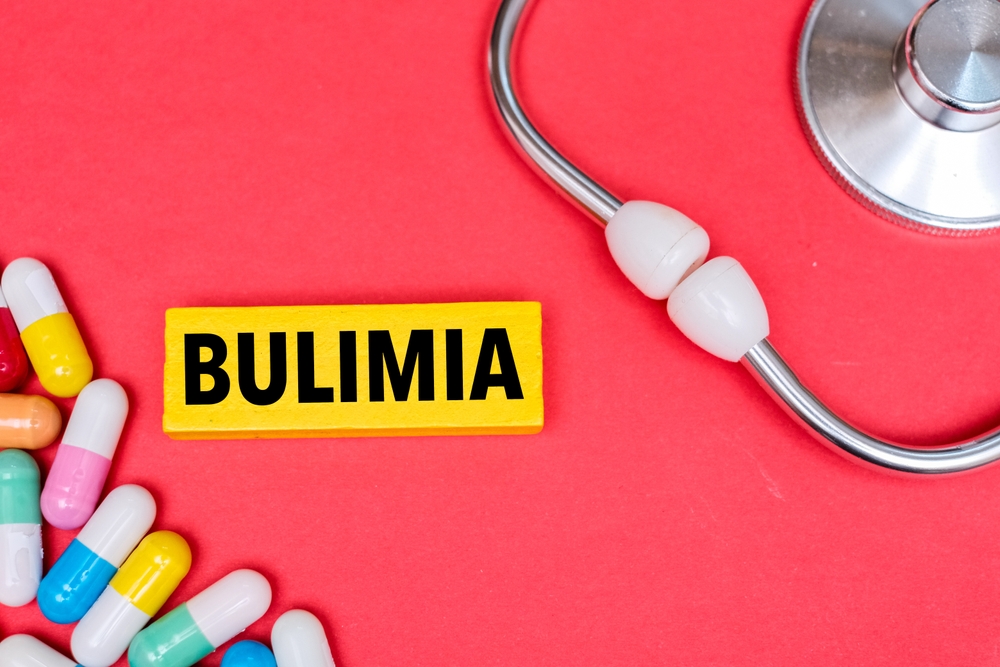Last Updated:
July 21st, 2025
Bulimia | Symptoms, Causes and Treatment Options
It’s hard to see bulimia from the outside. Unlike what you may expect, people with bulimia nervosa don’t always look underweight or unwell. That’s partly why it can go undetected for so long. Bingeing and purging become secret habits, hidden behind closed doors and smiles. But just because it’s hidden doesn’t mean it isn’t serious. Left untreated, bulimia can have lasting effects on both physical and emotional health.
The good news is that recovery is more than possible, especially with the right support and timely intervention.

What is bulimia?
Bulimia nervosa is an eating disorder characterised by a cycle of binge eating followed by attempts to compensate for the binge. That might involve purging (through vomiting or laxatives), excessive exercise or periods of fasting.
What drives this pattern is often a deeply rooted fear of gaining weight, paired with overwhelming guilt or shame after eating.
People with bulimia can feel as though they’ve lost all control during a binge. It may feel like something takes over, like a switch that flips and it’s only after the binge that the need to ‘undo’ the damage kicks in. These episodes are rarely about hunger; they’re more about comfort and emotion.
How is bulimia diagnosed?
According to the DSM-5 criteria, bulimia nervosa involves:
- Repeated episodes of binge eating, marked by a loss of control.
- Compensatory behaviours (like vomiting or fasting) used to prevent weight gain.
- Episodes occurring at least once a week for three months.
- A self-worth that’s disproportionately influenced by body shape and weight.
- it’s not better explained by another eating disorder like anorexia.
Only a qualified professional can make an official diagnosis, but recognising these patterns is the first step toward seeking help.
Types and severity
Bulimia doesn’t always look the same in everyone but a lot of the time, patterns emerge. These patterns may be loosely referred to as ‘purging’ or ‘non-purging’ types, though they’re not official subtypes in clinical diagnostics.
Severity is usually based on how often binge-purge cycles happen:
- Mild: 1–3 times a week
- Moderate: 4–7 times a week
- Severe: 8–13 times a week
- Extreme: 14 or more times a week
What causes bulimia?
It would be wrong to think bulimia begins because of one specific cause. The condition usually develops from a combination of factors that interact over time. Below, we take a look at some of the potential causes.
Research shows people with bulimia often score higher on measures of impulsivity and personality disorders compared to those without eating issues.
- Bloating, stomach pain, constipation
- Swollen glands, sore throat, dental issues
- Fatigue, disrupted sleep, irregular periods
- Electrolyte imbalances that may lead to heart issues
- Blood sugar changes and nutrient deficiencies
- Kidney strain and dehydration
- Intense shame and guilt about food
- Persistent anxiety or depression
- Distorted body image
- Low self-worth and disconnection from others
- Risk of suicidal ideation in some cases
The hidden toll of bulimia
Bulimia impacts nearly every part of a person’s health. It goes beyond the physical health issues and often affects mental and behavioural health, too.
- Bloating, stomach pain, constipation
- Swollen glands, sore throat, dental issues
- Fatigue, disrupted sleep, irregular periods
- Electrolyte imbalances that may lead to heart issues
- Blood sugar changes and nutrient deficiencies
- Kidney strain and dehydration
- Intense shame and guilt about food
- Persistent anxiety or depression
- Distorted body image
- Low self-worth and disconnection from others
- Risk of suicidal ideation in some cases
What does recovery from bulimia look like?
While bulimia can feel isolating, many people do recover and stay recovered.
In fact, more than half of those who seek help show full recovery within five years, with others continuing to improve over the next decade. The earlier you seek treatment, the higher your chances of long-term success.
Recovery involves far more than simply stopping the binge-purge cycle. It focuses on healing your relationship with food and learning how to cope with life without falling into old patterns.
What does treatment involve?
At Addiction Helper, we work with programmes that treat the whole person, not just the symptoms. Treatment for bulimia typically involves:
- Cognitive Behavioural Therapy (CBT): Helps identify and challenge distorted beliefs around food and body image.
- Dialectical Behaviour Therapy (DBT): Supports emotional regulation and distress tolerance, especially useful if impulsivity is a factor.
- One-to-one counselling: Offers a confidential space to explore personal history and emotional triggers.
- Group therapy: Encourages shared experiences and support among others facing similar challenges.
- Family therapy: Can help repair strained relationships and build a more understanding home environment.
- Holistic therapies (art, mindfulness, sound therapy): Aid in expression, stress relief and reconnecting with the body.
The aim of using these types of therapies is to give you the tools to stay well and find meaning in recovery.
How do I know if someone I care about has bulimia?
Because bulimia is so secretive, it can be difficult to spot. But there are some warning signs that may help you recognise it in a loved one:
- Disappearing after meals, especially to the bathroom
- Fluctuating weight, without any obvious cause
- Evidence of bingeing, like hidden food wrappers or large quantities of food disappearing
- Physical symptoms, like swollen cheeks, tooth erosion or sore throats
- Social withdrawal, especially from food-related situations
- Obsessive talk about weight, food or body shape, even when reassurance is given
You don’t need to diagnose them; it’s not your job to do so, but your concern might be the lifeline they need.

Take the first step
Whether it’s for yourself or someone you care about, reaching out can feel overwhelming. But taking that first step makes all the difference. A confidential chat with one of our advisors could be the turning point toward a more stable, balanced life.
At Addiction Helper, we work closely with treatment centres that offer personalised programmes for bulimia recovery. We’ll listen, help you understand your options and connect you with the right kind of support.
Call us today or request a callback. You’re not alone, and you don’t have to figure it out alone, either.
Our compassionate team are ready and available to take your call, and guide you towards lasting the lasting addiction recovery you deserve.
Frequently Asked Questions
(Click here to see works cited)
- Yilmaz Z, Hardaway JA, Bulik CM. Genetics and Epigenetics of Eating Disorders. Adv Genomics Genet. 2015;5:131-150. doi: 10.2147/AGG.S55776. Epub 2015 Mar 10. PMID: 27013903; PMCID: PMC4803116.
- Tagay S, Schlottbohm E, Reyes-Rodriguez ML, Repic N, Senf W. Eating disorders, trauma, PTSD, and psychosocial resources. Eat Disord. 2014;22(1):33-49. doi: 10.1080/10640266.2014.857517. PMID: 24365526; PMCID: PMC3966425.
- Mushtaq T, Ashraf S, Hameed H, Irfan A, Shahid M, Kanwal R, Aslam MA, Shahid H, Koh-E-Noor, Shazly GA, Khan MA, Jardan YAB. Prevalence of Eating Disorders and Their Association with Social Media Addiction among Youths. Nutrients. 2023 Nov 5;15(21):4687. doi: 10.3390/nu15214687. PMID: 37960340; PMCID: PMC10647586.
- Peterson CB, Thuras P, Ackard DM, Mitchell JE, Berg K, Sandager N, Wonderlich SA, Pederson MW, Crow SJ. Personality dimensions in bulimia nervosa, binge eating disorder, and obesity. Compr Psychiatry. 2010 Jan-Feb;51(1):31-6. doi: 10.1016/j.comppsych.2009.03.003. Epub 2009 May 2. PMID: 19932823; PMCID: PMC2838502.

